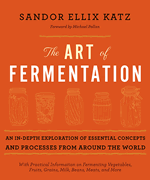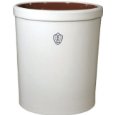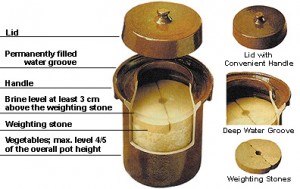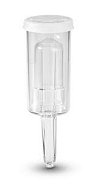While you always are welcome to attend one of my classes (which include detailed notes and hard-won tips for success), you can teach yourself, too. I did!
Helpful Books:
 The Joy of Pickling by Linda Ziedrich
The Joy of Pickling by Linda Ziedrich
Ziedrich is a gardener so her approach to ingredients is similar to my own. She includes charts to help you make appropriate brine strength for your ferments by the gallon and by the quart (this will allow you to experiment with smaller batches until you’re ready to make a big batch of something). She shares recipes for fermented pickles, sauerkraut, kimchi, fermented sauces, and even cultured rice-bran pickles. I feel that this book is an essential resource for anyone interested in live-cultured pickles.
 Wild Fermentation by Sandor Katz
Wild Fermentation by Sandor Katz
Katz hasn’t written a cookbook exactly… he offers suggestions and ways of thinking instead of recipes. Wild Fermentation is a personable, inspiring guide to the world of live-cultured foods that goes way beyond pickles and sauerkraut — exploring ways to make yogurt, sourdough, miso, and other bean ferments, too. I really like his low-tech, inexpensive solutions for fermenting vessels. Very empowering!
 Sandor Katz has a new book called The Art of Fermentation: An In-Depth Exploration of Essential Concepts and Processes from Around the World. I haven’t worked my way through it yet so don’t feel ready to share thoughts. However, it’s much longer and more thorough than the previous book. The how-to is in there, but it’s spread out. Wild Fermentation: The Flavor, Nutrition, and Craft of Live-Culture Foods keeps the how-to front and center.
Sandor Katz has a new book called The Art of Fermentation: An In-Depth Exploration of Essential Concepts and Processes from Around the World. I haven’t worked my way through it yet so don’t feel ready to share thoughts. However, it’s much longer and more thorough than the previous book. The how-to is in there, but it’s spread out. Wild Fermentation: The Flavor, Nutrition, and Craft of Live-Culture Foods keeps the how-to front and center.
Fermentation Vessels:
 You can use an old-style crock like this. Some come with wooden lids and weights. They’re becoming easier to find new, too. However, if you have an old one, you must make sure that it is in pristine condition — with no hairline cracks or chips in the glaze. These crocks require more work sometimes because it becomes necessary to skim off “scum” that may accumulate on the top of the brine, and — unless you cover it carefully with cheesecloth or a kitchen towel — you may find that your sauerkraut or kimchi has become a home to bugs or small flies.
You can use an old-style crock like this. Some come with wooden lids and weights. They’re becoming easier to find new, too. However, if you have an old one, you must make sure that it is in pristine condition — with no hairline cracks or chips in the glaze. These crocks require more work sometimes because it becomes necessary to skim off “scum” that may accumulate on the top of the brine, and — unless you cover it carefully with cheesecloth or a kitchen towel — you may find that your sauerkraut or kimchi has become a home to bugs or small flies.
 I really like these German-made crocks with a water seal. Harsch is one of the brands that is dependable. They come with nice, heavy weights to keep fermenting vegetables submerged under the brine. They are not a perfect solution, however. They are expensive, and they are very heavy when full. You need to consider where you’ll keep these big crocks during fermentation and how you will move them when they’re full of sauerkraut and how you will clean them after a batch is done. Those caveats aside, these crocks work brilliantly and are well worth the money if you are making sauerkraut and other long ferments regularly. I find that Canning Pantry offers some of the best prices on these crocks. Wherever you buy them, however, be mindful of extra shipping costs because these are very heavy.
I really like these German-made crocks with a water seal. Harsch is one of the brands that is dependable. They come with nice, heavy weights to keep fermenting vegetables submerged under the brine. They are not a perfect solution, however. They are expensive, and they are very heavy when full. You need to consider where you’ll keep these big crocks during fermentation and how you will move them when they’re full of sauerkraut and how you will clean them after a batch is done. Those caveats aside, these crocks work brilliantly and are well worth the money if you are making sauerkraut and other long ferments regularly. I find that Canning Pantry offers some of the best prices on these crocks. Wherever you buy them, however, be mindful of extra shipping costs because these are very heavy.
 For my classes, I’ve discovered another solution that eliminates many of the problems in using an old-fashioned ceramic crock and is much, much cheaper than a Harsch or Polish crock. We’ve been using glass jars with airlock stoppers. You can make a jar like this yourself with a jar, a rubber stopper, a plastic airlock (usually less than $5) and a drill. You also can buy ready-to-use fermenting jars in different sizes from Cultures for Health or Pickl-It. The airlock allows gases to escape during fermentation, while preventing oxygen from entering. Even better, you can watch your vegetables bubble and change color while they ferment. This solution isn’t perfect either. There isn’t a way to weigh down the vegetables and keep them submerged under the brine. Sometimes we have to sacrifice the very top layer of sauerkraut, for instance, because it has become oxydized from exposure to a minimal amount of oxygen. However, for the price, airlock jars bring great comfort to me as a teacher. When I send students home with airlock jars filled with sauerkraut or kimchi, I feel confident that their ferments will be successful.
For my classes, I’ve discovered another solution that eliminates many of the problems in using an old-fashioned ceramic crock and is much, much cheaper than a Harsch or Polish crock. We’ve been using glass jars with airlock stoppers. You can make a jar like this yourself with a jar, a rubber stopper, a plastic airlock (usually less than $5) and a drill. You also can buy ready-to-use fermenting jars in different sizes from Cultures for Health or Pickl-It. The airlock allows gases to escape during fermentation, while preventing oxygen from entering. Even better, you can watch your vegetables bubble and change color while they ferment. This solution isn’t perfect either. There isn’t a way to weigh down the vegetables and keep them submerged under the brine. Sometimes we have to sacrifice the very top layer of sauerkraut, for instance, because it has become oxydized from exposure to a minimal amount of oxygen. However, for the price, airlock jars bring great comfort to me as a teacher. When I send students home with airlock jars filled with sauerkraut or kimchi, I feel confident that their ferments will be successful.
And, yes, you can use regular jars without fancy tops, too. You can use a big bowl, a plate, and a sterilized rock. You can use nested plastic buckets. The goal is to keep the vegetables in as anaerobic of an environment as possible during the entire course of their fermentation.

I have been enjoying sauerkraut in a stir fry of shredded cabbage, chopped kale and bulk ground sausage. Does heat destroy the benefits of the probiotics created in the fermentation of sauerkraut?
Barbara, your recipe sounds delicious. Yes, heat does destroy the probiotics. However, it’s wonderful to cook with fermented foods because of the depth of flavor that they add. I often recommend putting the sauerkraut or kimchi into the recipe at the end of cooking — or just sneak a spoonful of fresh sauerkraut while you’re cooking!